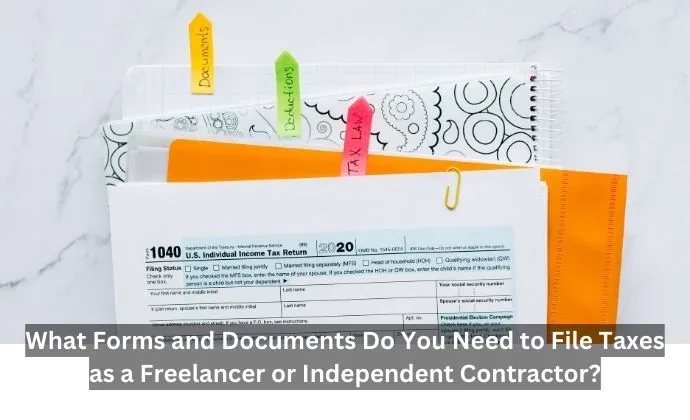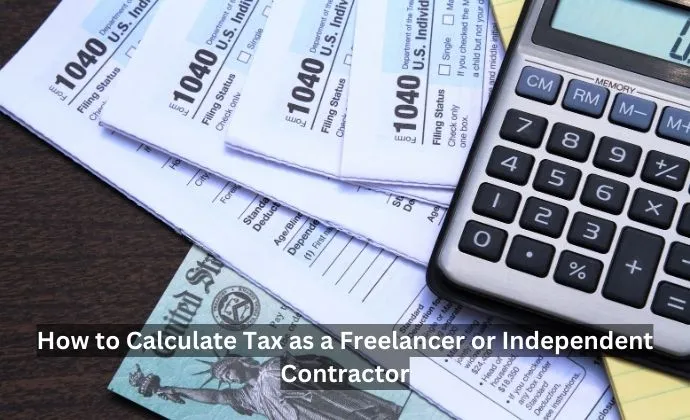Independent Contractors Tax Filing Guide - How to File Taxes as a Freelancer
Filing taxes as an independent contractor can be confusing and intimidating.
Questions like, "Will I get into trouble?" "What are the various rates?" "Am I missing anything?" must be bombarding your mind.
But don't worry! Check out our freelance tax guide to learn everything you must know to file taxes as a freelancer or independent contractor.
Who Is an Independent Contractor?
People who deliver goods or perform services for customers, clients, patients, or other individuals are independent contractors and not employees.
According to the Internal Revenue Service IRS, independent contractors include dentists, veterinarians, doctors, lawyers, contractors, subcontractors, accountants, auctioneers, or public stenographers.
However, the legal status of workers classified as independent contractors depends on the circumstances.
When determining a person's status as an employee or independent contractor, the IRS examines whether the person is eligible to direct or control only the business' result. If they are, then they are an independent contractor.
But if an individual controls the work and dictates what, when, where and how to proceed, he is not an independent contractor. It also includes people who offer services and work under an employer even if they enjoy the freedom of action.
As an independent contractor, the government considers you self-employed. You owe self-employment tax on your net earnings as an independent contractor.
It means you have to report your income, pay social security and Medicare taxes to the IRS, and make estimated tax payments throughout the year.

Who Is a Freelancer?
Freelancer is a general term for people who work as independent contractors. A freelancer can be an artist, a writer, or a computer programmer.
They tend to work for multiple clients at a time and are involved in projects with shorter durations than those of an employee.
Freelance workers may calculate their earnings hourly or daily, depending on how their contracts are structured. Many freelancers also charge per job or project based on rates that may vary among clients.
How Do You Know if You Are a Freelancer or an Independent Contractor?
Freelancers can be either full-time or part-time self-employed workers. The government requires those who freelance full-time pay taxes like any other self-employed person, given that their annual freelance earning exceeds $400.
They offer services to clients on an as-needed basis, often working from a home office. Freelancers may also work on short-term projects for multiple individual clients instead of working for one company as an employee does.
An independent contractor is an individual who works on a contract basis for a business or other people. Such people offer services to another entity or organization as a non-employee.
While freelancers usually work alone, independent contractors are associated with a business, agency, or organization. They also work for longer durations, such as a few months, a year, or more.
In each case, you handle your income taxes independently since you are self-employed.
What If You Work as an Employee and an Independent Contractor?
If so, you may need to learn about additional tax responsibilities, such as filing quarterly estimated taxes and paying self-employment taxes.
If you want to learn how to pay taxes as an independent contractor while being an employee, you must know the additional tax responsibilities, which are as follows:
Self-Employment Tax
If you work for yourself, you must learn about self-employment taxes, including Medicare and social security taxes.
Self-employment taxes apply to any income from freelancing or contracting that you generate as a self-employed worker.
In an employee-employer situation, this tax becomes 50-50; both parties pay their portion. But because you are self-employed, you are in charge of both portions.
One of the great things about being an independent contractor is that you will get to deduct one-half of these taxes, which is equivalent to the employer portion. So, when you file your tax return, you can usually expect a respectable sum.
Quarterly Estimated Taxes
Your employer withholds taxes from your paycheck throughout the year when you work as an employee.
If you are self-employed, you need to make estimated tax payments quarterly instead of routinely paying taxes from your paycheck.
To avoid being hit with a giant bill at the end of the year, it is vital to keep track of your income and expenses during each quarter, so you know how much to pay. Learn about the quarterly estimated taxes dates here.
Independent Contractor Tax Deductions
Self-employed workers can deduct many business expenses, including work equipment, and travel. Depending on your work situation, you may be able to subtract the costs related to your home office, mileage, and more.
Basics of Independent Contractor Taxes

Being self-employed comes with some extra paperwork and responsibilities. It’s crucial to keep track of them, so you don't fall behind.
As an independent contractor, you must pay estimated taxes and fill out additional forms. Independent contractor taxes revolve around four main differences that do not apply to an employee.
These are:
- Self-employment tax on Schedule SE
- Self-employment income and deductions on Schedule C (Form 1040)
- Quarterly estimated taxes
- Filling freelance tax Form 1099-MISC instead of a W-2
How to File Taxes as an Independent Contractor
Independent contractors report their income and expenses on Schedule E or Schedule C of Form 1040. Single-member limited liability companies (LLCs) or sole proprietors must show net profit and loss from their businesses on these tax forms.
Besides, self-employed individuals must also file quarterly estimated taxes with the IRS. They must also submit a 1040-ES Form to the IRS every quarter, along with payment of taxes owed.
Taxes for sole proprietors, independent contractors, and small business owners are generally something you pay on your net income. Your business may not include taxes as part of its overhead.
However, you should know that the difference between your gross earnings and business expenses is your taxable income - net income.
For the tax year 2023, all independent contractors' covered wages are subject to Medicare and social security taxation, paid by the employer.
Since self-employed individuals pay all of their business expenses, they can also deduct those expenses from their taxes.
So, according to the IRS Social Security rate, individual contractors must pay 12.4% on the first $160,200 of net income. Plus, Medicare tax contributions equal 2.9% of all net income.
If you are self-employed and a single filer, you must pay an additional 0.9% Medicare tax on self-employment income over $200,000.
The limit is $250,000 for married couples filing jointly. As a result of this increase, the total self-employment tax rate increases to 16.2%.
The production of products that you sell in certain states may require you to pay sales taxes. However, the type of product you are making as an independent contractor determines if you need to pay a sales tax.
What Forms and Documents Do You Need to File Taxes as a Freelancer or Independent Contractor?

As a freelancer, you may already know that the tax forms you file differ from those of employees. W-2s from your employer does not apply to self-employed earnings or independent contractor payments.
So, ensure you have the correct information ready when it comes time to fill the necessary forms. You can also use our calculator to generate independent contractor pay stubs.
Following are some crucial forms that will help you learn how to pay taxes as a freelancer or independent contractor.
Form 1099-Misc
As a freelancer, you must fill out Form 1099-MISC and send it to the IRS along with your other tax forms.
The Federal Tax Form 1099-MISC is used by businesses (individually, as sole proprietors, or as partnerships), professional service providers, and certain other entities to report freelance income and expenses.
If your entire income comes from freelancing, it would all show on Form 1099-MISC. However, if you have multiple types of income unrelated to freelancing, you might split your earnings between a W-2 and a 1099-MISC form.
You will receive a 1099-MISC Form from your contract companies. If you work for multiple businesses, collect 1099-MISC forms from each one. This is so you can have everything in one place when you file your taxes.
Note that Form 1099-NEC is now in use for independent contractors and self-employed individuals, but Form 1099-Misc is still around.
Finding it difficult to understand this form? Check out the 1099 Pay Stub for Contractors.
Form 1099-K
1099-Ks are, for the most part, issued to merchants and businesses, but some third parties might also send them to individuals.
All of your payment network accounts, aka, "payment settlement entity," or, "PSE," should send you a 1099-K form if you received over $600 in a calendar year.
Third-party settlement organizations (the "PSEs") include services like Venmo, Zelle, Cash App, and PayPal. Consumers use these apps to make and receive payments using their mobile devices or computers.
The 1099-K form issues a reportable payment transaction from a business to a vendor and provides information such as the dollar amount paid, the date of the transaction, and more.
If you contracted with a company or individual and that person did not send you a 1099-MISC form, you'll need to report what you were paid via PSE on your tax return. Thus, this form becomes a crucial part of your tax filings to the IRS.
Form 1040-ES
If you're curious about the requirements for estimating quarterly taxes, form 1040-ES is what you should target. That's because it provides instructions for how to estimate your taxes and make payments throughout the year.
If you want to pay your quarterly taxes online instead of filling out a form, there's a tool on IRS that can help you do that too.
Form W-9
You might have received a W-9 form if you worked as a freelancer for a business.
The W-9 is an official tax document that requires your name, address, and taxpayer information. Companies use the information you fill out on this form to report the payments disbursed to freelancers and individual contractors.
Other Documents
You'll need to add other documents when filing your taxes, such as tax deductions. You can deduct taxes on things like software, home office setup, business incorporation, mileage, utilities, and even courses you take to better yourself as a freelancer.
However, some freelancers, as the sole workers in their companies, might exaggerate these deductions. The IRS often gets suspicious, and audits aren't uncommon.
How to Calculate Tax as a Freelancer or Independent Contractor

As a freelance individual, you'll be responsible for paying federal and state income tax on your business income. Additionally, you must also pay self-employment tax (the equivalent of old-age insurance), which is 15.3% of your net business income.
Payable Taxes
Self-employment Tax
Self-employment tax, also known as FICA, consists of social security and Medicare taxes for freelance individuals. The self-employment tax rate is 12.4% and 2.9%, respectively, making a total self-employment tax rate of 15.3% of net income.
When you’re a freelancer, you need to pay both the employer and employee portion of FICA tax. Filing Schedule SE, Form 1040, and your income tax return helps you pay the self-employment tax.
Income Tax
On top of paying the self-employment tax, you will also have to pay income taxes, just like any other taxpayer.
First, your annual taxable income is the sum of your yearly income minus any allowable deductions.
Next, consult the tax tables for that current year to find out what percentage of your taxable income you need to pay in income taxes.
Other Taxes
Besides these taxes, your state and municipality may also have their tax policies. Those can be more complicated than the federal tax requirements as they vary from state to state and municipality to municipality.
You can find out what you need to pay in addition to federal taxes by looking at the tax authorities for your state and municipality.
Check out this directory to all US state tax authorities for more information.
Calculating Your Freelance Taxes
You can use the Estimated Tax Worksheet to calculate how much you need to pay, which will show on Form 1040-ES.
You’ll report this amount four times annually when you file Form 1040-ES to pay your estimated quarterly taxes.
Or make pay stubs if self-employed using our pay stub generator.
Tax Deductions and Benefits for the Self-Employed
Even if you work as an employee, the following tax deductions apply to you if you are also a self-employed individual.
- Qualified Business Income Deduction
- Home-office deduction
- Internet and phone
- Traveling, car, and driving-related deductions
- Self-employed health insurance deduction
- Deduction for one-half of self-employment tax
- Advertising
- Business meals
- Professional development costs
- Software costs
- Licensing and fees

Home-Office Deductions
You can deduct home office costs on your taxes if you maintain an office at home. The first thing you'll need to do is calculate the overall size of your home or apartment about where you want your home office to be.
The IRS recommends calculating rent based on the square footage of that specific area. You can also use the simplified option, which deducts $5 per square foot of office space.
Home-Office Utilities
You can also calculate your home office utility costs, but only for the space you use for your business. Calculate costs like electricity, gas, heating, air conditioning, internet, and phone service to determine your monthly bills.
Travel Expenses
Traveling for work as a freelancer? You can deduct the cost of your mileage from your taxes. The IRS releases standard mileage rates every year, which you can use to figure out how far you drove and the cost to deduct.
For the year 2023, the standard rates are:
- Per mile driven charges - 14 cents (in service of charitable organizations)
- Per mile driven charges - 22 cents (for medical or moving purposes)
- Per mile driven charges - 65.5 cents (for business use)
FAQS
What is the latest self-employment tax rate?
The self-employment tax is a social security and Medicare tax imposed on self-employed people, generally amounting to 15.3% up to $160,200 of net earnings from self-employment.
It breaks down to a 12.4% social security tax and a 2.9% Medicare tax.
Do freelancers pay less taxes?
While it isn’t always the case, the tax advantages for freelancers are more substantial than those for employees.
This is because self-employed people have more scope to deduct work-related expenses from their income. However, they still pay 15.3% of employment tax and federal and state taxes.
How to report freelance income without a 1099?
If you don’t have a 1099 form and must report freelance income, you can use Form 1040 Schedule C to submit your business income and expenses. Freelancers must provide their social security number and the EIN of their business on this form to qualify for deductions and credits.
Final Thoughts on Independent Contractor (Self-Employed) or Employee Taxes
And that's our freelancer tax guide. These are all the main points you should know about filing taxes as a freelancer and the documents needed. Make sure to file your taxes before the deadline to avoid a call from the IRS.
Kristen Larson is a payroll specialist with over 10 years of experience in the field. She received her Bachelor's degree in Business Administration from the University of Minnesota. Kristen has dedicated her career to helping organizations effectively manage their payroll processes with Real Check Stubs.

